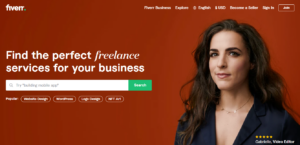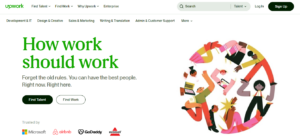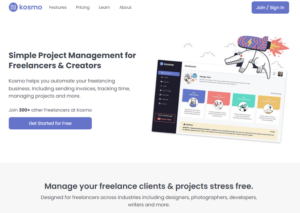How To Get Graphic Design Clients For Your Design Agency

Graphic designing is one of the emerging careers in 2022. Every large organization has a need for creative art for the success of all businesses. So, there is a massive demand for Graphic Designers.
Graphic designing has an immense scope, from web designing to corporate branding, from promotional items to print production.
So, as we can see, graphic designers will always be on the top of the wanted list because they carry potential skills that are required by every business. So, if there is massive demand in the market for graphic designers, then where are graphic designers lacking?
The answer to this is that graphic design is a vast skill. In this competitive corporate world, businesses are looking for freelancer niche-specific graphic designers. Why freelance now?
Because companies are cutting their office expenses and want graphic designers to work on a requirement basis, the point is: How does a graphic designer know a company is looking for them?
So, here comes the main hot topic “How to get graphic design clients in 2022?”
So, all the graphics designers out there reading this blog, stay tuned because I will break down the whole process of getting the client into 10 easy step-by-step strategies for you.
Getting a graphic design client is no hard and fast rule if you rigorously follow the below-mentioned strategies.
Here they are:
- Identify your niche and narrow it down ( focus on your niche)
- Decide what you value and stick to it
- Create your portfolio and optimize it
- Register with job sites – Upwork, Fiverr, FlexJobs
- Go where graphic clients already are ( follow your graphical design clients)
- Utilize social media to create valuable content and market it
- Make sure everything is up-to-date
- Networking with a network – ask for referrals and recommendations
- Make use of social proof
- Follow-up is consequential, so don’t ignore it
Let’s take a brief look at the steps necessary to find new clients for your freelancing business.
Step #1
Identify your niche and narrow it down ( focus on your niche)
Choosing a niche and narrowing it down seems easy, but it’s the most tricky thing ever. We never know which niche is profitable and which is not, which is most demanding and which is not?
First, you must find out the areas you are interested in. Rather than describing yourself as a general graphic designer, you can be more specific with your specialized generic fields and look far more professional.
You won’t believe this step of narrowing will do 50% of your work and double your chances of getting the client sooner.
Let’s understand this with an example,
Suppose there is a Gaming company looking for a graphic designer. Whom will they approach?
- A graphic Designer
- 3D and Animation Specialist Graphic Designer
I know the definite answer is Option B. Reason being in this scenario, the gap between graphic designer and client reduces.
Clients will get to know that you are specialized in what they are looking for. And you will also deliver the best out of it being specialized in a particular generic field.
If you find it challenging to find a niche, click here.
Step #2
Decide your value and stick to it
After knowing your niche, you should be clear on your values because values set you apart from the crowd.
There are high chances of converting a client if you can communicate your values to your clients.
To know your value, sit back and answer these questions.
- What is a unique or special skill you have?
- What sets you apart from other competitors?
- What will you provide to your clients that other designers don’t?
Most graphic designers skip this step, and this is where they lack. Let me make it easy for you.
Understand with the above example,
Suppose you have an experience in the gaming industry in 3D and animation graphics. In that case, you will have more value for your clients because you understand the needs and requirements of that industry better than others.
So, communicating value to clients is essential. You can add your achievements to your portfolio, display awards and results of past projects, etc.
Step #3
Create your portfolio and optimize it
The portfolio is the foremost thing that leaves the first impression on your client. It would help if you were sure to make your portfolio as best as possible.
The portfolio is one of the crucial assets for winning graphic design clients.
Your portfolio must communicate the best of all of your past projects. This can be a win-win position if you update your portfolio regularly.
There are a few things to keep in mind while making a portfolio. Check this out.
Must Include :
- Who you are
- What you do
- Your Previous Works/Projects (The best ones)
- Easy Portfolio Format
- How to Get in Touch with you
Step #4
Register with job sites – Upwork, Fiverr, FlexJobs
The fastest and easiest way to get graphic design clients is to sign up on trending and fast-growing freelancing websites. Here are the very high chances that you get a client.
There is a massive list of freelancing sites, but these are the best places where you can sign up and get your first client now.
- Fiverr

The most loved and preferred freelancing site is Fiverr and we published an article about Fiverr’s pricing structure as well. You set your hours, and you can set your days, you can specify additional charges and whatnot. It helps you build your little empire. Yes, empire (lol).
Fiverr has many opportunities where you can create your gigs in just a few minutes and live in your empire to get the client. Fiverr has a couple of different charges for sellers and buyers.
It’s pretty easy to become a seller on Fiverr, so you can get started finding clients in a matter of minutes.
- Upwork

I have chosen Upwork here because it is the most helpful marketplace that can help you get graphic design clients. As per my experience, it takes a bit more time to set up the account than in other marketplaces but spending time here is worth every second.
Upwork has so many opportunities for freelancers that many graphic designers are getting full-time living opportunities for this.
- Flexjobs

My last favorite freelancing job site for getting graphic design is Flexjobs. They provide many opportunities for specific fields. The interface is easy to use and a quick solution for getting a graphic design client.
It will not disappoint you anyway!
Step #5 Go where graphic designing clients already are ( follow your graphic clients)
Conversely, if the client is not searching for you, you go where the client is already present.
That makes sense, right?
This is one of the most beautiful strategies to get your living from graphic design. There are many conferences, business meet-ups, or local working spaces where industry people hang around, available almost everywhere.
You need to figure out a few and catch up with them there.
#Networking Is Always A King
But if not offline, then online is just a matter of clicking. Open your Facebook and Instagram, join groups, see your clients and you are all done. Not just this, Linkedin is also a great hit where you get potential clients of graphic design.
Step #6
Utilize social media to create valuable content and market it
Is Anything more potent than Social Media? I guess NO!
Social Media is one of the most potent assets anyone can have.
You might not have followers, likes, or subscribers as a beginner. But learn social media, use hashtags and catchy captions, make attractive thumbnails, and make reels because content goes viral like a fire on social media.
Use a business account, maintain a professional presence, and upload your work so that if someone finds it attractive, they will follow you. Likewise, you will start getting clients and orders from social media.
Step #7
Make sure everything is up-to-date
Regular posting and regular presence make you look available for work. It creates a high chance of getting a graphic design client because they are usually curious to see the latest work rather than the same monotonous work.
So, it would be best if you were up-to-date on your platforms. No matter how they result for you, you should be active with the latest trend and projects so that nothing will be left behind.
Step #8
Networking – ask for referrals and recommendations
“Don’t run behind the opportunity. Create the opportunity.” Yes, this phrase is so suitable for graphic designers because they are the ones who are required in every service field and every potential business.
So, you need to go out and create opportunities for yourself. Have meetings, introduce yourself, give proposals on how you can be beneficial for them and their success, and see the results then!
Why should they not hire you at that exact moment? They will employ or connect you with someone who needs your skills by referring you.
So, always network and grow 3x.
Meanwhile, references and recommendations are also compelling but mostly not taken seriously. Always ask for feedback from your client after the submission of your work. It not only helps you in improvement but also creates a bunch of reviews for you to showcase to your clients.
There are many marketing tools available online, but till today, Word of mouth is considered and given importance by the big firms to grow.
Step #9
Make use of social proof
Taking reviews is fine, but do post them on social media. After seeing the testimonials, there is double the chance to build trust and convert it into your regular paid client.
Trust in mind is the main point where clients decide whether they will onboard you.
You can ask your clients to give you feedback and recommendations on your website, which will be helpful for you to learn about your values.
Because it’s human nature, if a client sees that you have done excellent work for another organization, they recommend you. They will ultimately be assured of your skill and provide you with work.
Also, add a social proof page on your website column too.
Step #10
Follow-up is consequential, so don’t ignore it
Last but not least, there are high chances of getting lots of queries but no revert later. Or it might be that some of them asked for your portfolio and didn’t get back.
What to do, then?
Write a follow-up.
Some of you might think they will get back to us if they are interested, but if they don’t, they are not likely to take the services.
Someone who reached out in the first place is the most crucial customer base which has high chance of converting into potential clients because they enquired after looking at your profile and asked for a portfolio because they are already interested.
So, most of them get busy or skip and ignore it for some reason. Still, your follow-up reminds them to have a look again, and this step conveys that you care about their business and gives a thumbs up to your value.
Get going!
Once you get the client, then to help you out, let me share one freelance business management tool which will help you to provide value to your customer.
There is different project management software out there; some are paid, and some are free, but choosing the best is still confusing.
KOSMO is a great tool I use for my clients. It helps me create professional graphic design invoices, contracts and proposals in a blink of an eye with the help of their beautiful templates.

Kosmo’s platform is easy to use and manage. It helps you to manage your business smoothly with customizable documents.
For beginners, freelancers, and small business owners, it is the best tool to work with your client. It will save you time so you can invest that in your creativity,
Some might be thinking, “How much does Kosmo Cost?”
It’s $0 (FREE). Yes
Its plan starts from $0 up to $9 per month. You can upgrade your plan if you grow your client base.
Get Organized & Win More Clients
Kosmo has everything you need to run your freelancing business.